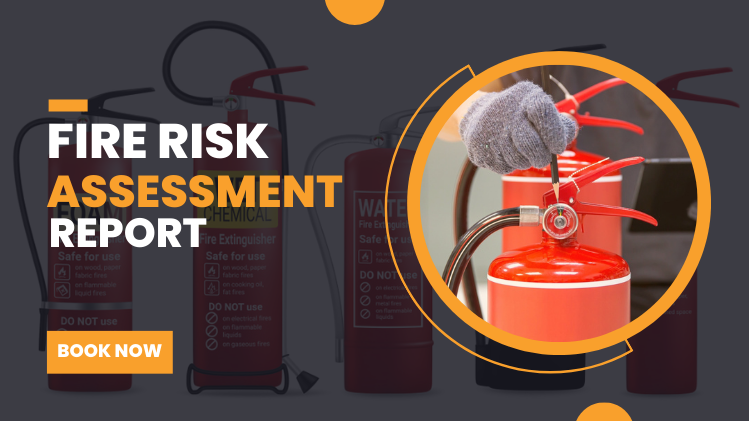Fire Risk Assessment Report
Get in touch
Mon - Sat 9:00 - 18:00
Sunday CLOSED

If you want to ensure the safety of your premises in London, conducting a thorough fire risk assessment is essential. It allows you to identify potential fire hazards, evaluate the associated risks, and develop an action plan to mitigate those risks effectively. Fire Risk Assessment Report is usually asked by your local council or authority when applying mandatory HMO license.
When it comes to fire safety, conducting a comprehensive fire risk assessment is crucial. Its importance, legal requirements, steps involved, and the benefits of hiring a professional fire risk assessor. By understanding the components of a fire risk assessment report, you will be better equipped to ensure the safety of your premises and protect lives and property.
Remember that a fire risk assessment should be conducted regularly, with periodic reviews and updates to ensure ongoing compliance and effectiveness. By prioritizing fire safety and maintaining a proactive approach, you demonstrate your commitment to the well-being of everyone within your premises
ESTIMATE FORM
Get Free Quote
Our Coverage Areas:
We provide EICR Certificates to landlords, house sellers, home buyers, and estate agents in all Boroughs of London, M25 Areas, Grays, and Stanford-le-Hope.
Our Pricing:
Fire Risk Assessment Report cost is fixed and all-inclusive there is no tax to add. Congestion, ULEZ and Parking will be charged for the Central London
Fire Risk Assessment Report: An Overview
A fire risk assessment report is a detailed evaluation of the potential fire hazards and risks present within a specific location. It involves identifying fire hazards, assessing the risk level, and developing an action plan to mitigate those risks. The report serves as a crucial document for property owners, managers, and authorities to ensure compliance with fire safety regulations.
Importance of Fire Risk Assessment
Fire risk assessments play a vital role in safeguarding lives, properties, and businesses. By identifying potential fire hazards and implementing appropriate safety measures, the risk of fire incidents can be significantly reduced. Furthermore, conducting regular fire risk assessments ensures ongoing compliance with legal requirements and demonstrates a commitment to fire safety.
Legal Requirements for Fire Risk Assessment
In London, as well as in many other jurisdictions, fire risk assessments are mandatory for most premises. The Regulatory Reform (Fire Safety) Order 2005 sets out the legal requirements for fire safety in non-domestic premises. It states that a suitable and sufficient fire risk assessment must be conducted, documented, and regularly reviewed by a responsible person.
Steps in Conducting a Fire Risk Assessment
To create an effective fire risk assessment report, several key steps must be followed. Let’s delve into each step in detail.
Gathering Information
The first step in the fire risk assessment process is gathering relevant information about the premises. This includes the size of the property, its intended use, occupancy levels, and any existing fire safety measures already in place.
Identifying Fire Hazards
During this stage, a thorough inspection is conducted to identify potential fire hazards. This may include flammable materials, faulty electrical systems, inadequate fire escape routes, or improper storage of combustible substances.
Evaluating Fire Safety Measures
Once the hazards are identified, the existing fire safety measures are assessed. This involves examining fire alarms, emergency lighting, fire extinguishers, sprinkler systems, and other protective equipment to ensure they are in good working condition and comply with relevant standards.
Assessing the Risk Level
The risk level is determined by considering the likelihood of a fire occurring and the potential consequences if it does. This assessment takes into account factors such as the presence of vulnerable individuals, the nature of activities carried out on the premises, and the effectiveness of existing fire safety measures.
Creating an Action Plan
Based on the identified hazards and risk assessment, an action plan is developed. This plan outlines the necessary measures to mitigate the identified risks and enhance fire safety. It may include recommendations such as improving fire detection systems, implementing fire-resistant materials, conducting staff training, and establishing emergency evacuation procedures.
Implementing Safety Measures
After the action plan is created, it is important to implement the recommended safety measures. This may involve installing new fire safety equipment, conducting necessary repairs or upgrades, and ensuring that staff members are trained in fire safety protocols. Regular maintenance and testing of fire safety systems should also be carried out to ensure their effectiveness.
Monitoring and Reviewing
Fire risk assessments are not a one-time activity. It is essential to regularly monitor and review the implemented safety measures to ensure their ongoing effectiveness. This includes periodic inspections, testing of equipment, and updating the assessment report as needed. Regular reviews help to identify any changes in the premises, new fire hazards, or updates in fire safety regulations that may require further action.
Benefits of Hiring a Professional Fire Risk Assessor
While it is possible to conduct a fire risk assessment London in-house, hiring a professional fire risk assessor offers several advantages. The experts of Landlord Property Certificates have in-depth knowledge and experience in identifying potential fire hazards and assessing risks accurately. Our engineers are familiar with local fire safety regulations and can ensure compliance. Our qualified and professional assessors provide unbiased evaluations and recommendations, helping property owners and managers make informed decisions to enhance fire safety.
If you need a Fire Risk Assessment Report in London and M25 areas, please Get in Touch With Us today. We will be happy to carry out an inspection and provide you with a certificate.
Fire Risk Assessment Report Components
A fire risk assessment report typically includes the following components:
- Executive Summary: A concise overview of the assessment, highlighting key findings and recommendations.
- Premises Information: Details about the property, its purpose, occupancy levels, and any relevant documentation.
- Methodology: Explanation of the approach taken and methods used during the assessment.
- Hazard Identification: Comprehensive list of identified fire hazards within the premises.
- Risk Assessment: Evaluation of the likelihood and potential consequences of a fire incident.
- Action Plan: Detailed recommendations for mitigating risks and enhancing fire safety.
- Fire Safety Measures: Description and assessment of existing fire safety measures in place.
- Emergency Procedures: Clear instructions for emergency response, evacuation plans, and assembly points.
- Training and Awareness: Information about staff training programs and fire safety awareness campaigns.
- Maintenance and Testing: Guidelines for regular maintenance, inspection, and testing of fire safety equipment.
- Review and Update: Recommendations for periodic reviews and updates to the assessment report.
- Appendices: Supporting documents such as photographs, test records, and maintenance logs.
FAQs
How often should a fire risk assessment be conducted?
Fire risk assessments should be conducted regularly, typically at least once a year or whenever there are significant changes to the premises.
Can I conduct a fire risk assessment myself?
While it is not possible to conduct a fire risk assessment yourself, it is mandatory to hire a professional fire risk assessor. They are certified and experienced to conduct a thorough assessment, identify potential hazards, and provide accurate recommendations. This ensures a comprehensive evaluation of fire risks and enhances the effectiveness of the assessment.
Are there specific regulations for fire risk assessments in London?
Yes, fire risk assessments in London are governed by the Regulatory Reform (Fire Safety) Order 2005, which sets out the legal requirements for fire safety.
How long does a fire risk assessment typically take?
The duration of a fire risk assessment depends on the size and complexity of the premises. It can range from a few hours for small properties and several days for larger or more complex buildings.
What happens if I fail to comply with fire risk assessment regulations?
If you fail to comply with fire risk assessment regulations, you may face legal consequences and potential penalties. Non-compliance with fire safety regulations can result in enforcement actions, fines, or even closure of the premises until the necessary safety measures are implemented. It is crucial to prioritize fire safety and ensure that you meet the legal requirements to protect lives, property, and business continuity.


